语言类型学第六章
- 格式:ppt
- 大小:132.50 KB
- 文档页数:27
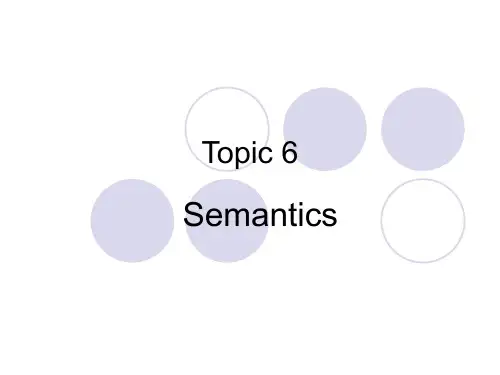


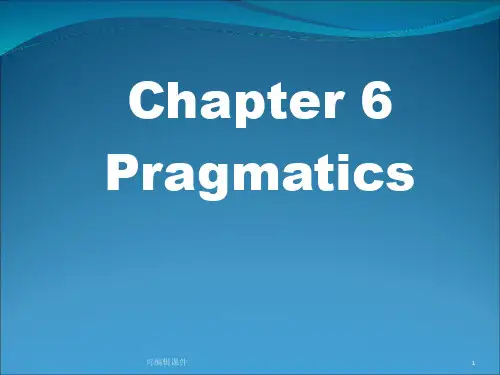

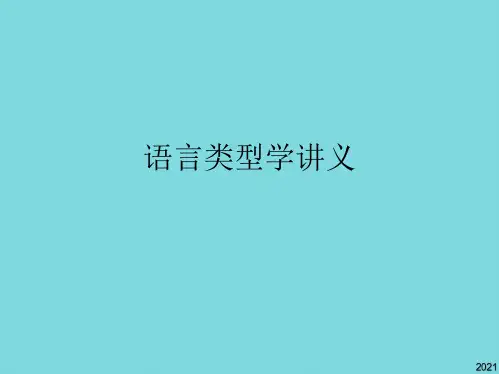
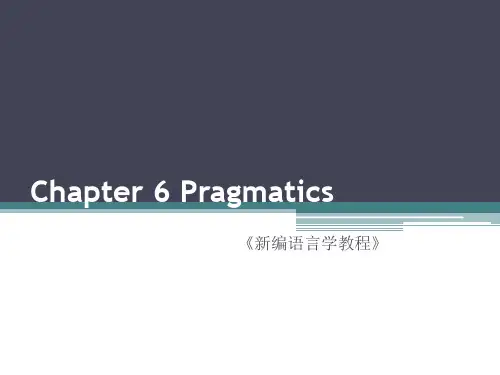
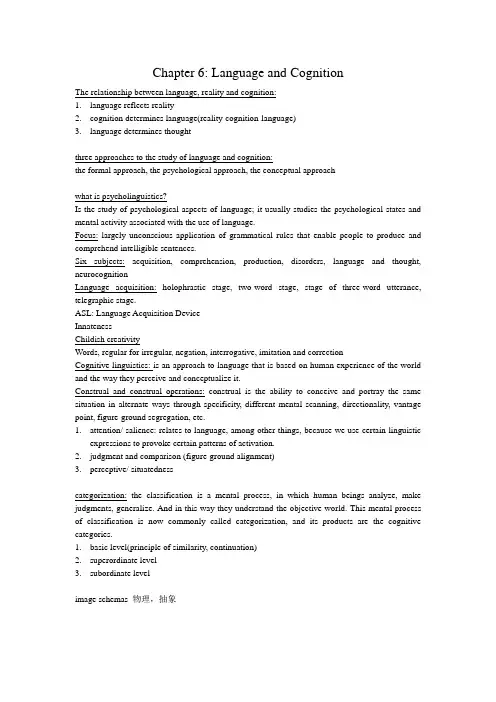
Chapter 6: Language and CognitionThe relationship between language, reality and cognition:nguage reflects reality2.cognition determines language(reality-cognition-language)nguage determines thoughtthree approaches to the study of language and cognition:the formal approach, the psychological approach, the conceptual approachwhat is psycholinguistics?Is the study of psychological aspects of language; it usually studies the psychological states and mental activity associated with the use of language.Focus: largely unconscious application of grammatical rules that enable people to produce and comprehend intelligible sentences.Six subjects: acquisition, comprehension, production, disorders, language and thought, neurocognitionLanguage acquisition: holophrastic stage, two-word stage, stage of three-word utterance, telegraphic stage.ASL: Language Acquisition DeviceInnatenessChildish creativityWords, regular for irregular, negation, interrogative, imitation and correctionCognitive linguistics: is an approach to language that is based on human experience of the world and the way they perceive and conceptualize it.Construal and construal operations: construal is the ability to conceive and portray the same situation in alternate ways through specificity, different mental scanning, directionality, vantage point, figure-ground segregation, etc.1.attention/ salience: relates to language, among other things, because we use certain linguisticexpressions to provoke certain patterns of activation.2.judgment and comparison (figure-ground alignment)3.perceptive/ situatednesscategorization: the classification is a mental process, in which human beings analyze, make judgments, generalize. And in this way they understand the objective world. This mental process of classification is now commonly called categorization, and its products are the cognitive categories.1.basic level(principle of similarity, continuation)2.superordinate level3.subordinate levelimage schemas 物理,抽象metaphor: involves the comparison of two concepts in that one is construed in terms of the other.1.the foundation of Gestalt Psychology (the principle of similarity, proximity, continuation,prominence)2.metaphor as a figure of speech3.conventionalized metaphor4.metaphor as cognitive instrument(time is money)types of metaphor:1.ontological metaphor: inflation is an entity. We are out of trouble now.2.structural metaphor: time is money. Argument is war.3.orientational metaphor: happy is up; sad is down.Novel metaphor: literature metaphor, scientific metaphorMetonymy and metaphor:1.similarities: both are seen being conceptual in natureboth can be conventionalizedboth are means of extending the resources of a languageboth can be explained as mapping processes2.differences: metaphor involves a mapping process across different cognitive domain whilemetonymy is a mapping within one domain, close or relevant domain.Metonymy involves the relation of closeness and salience.General conceptual configuration:1.part for wholewhole for part (bathroom, the united states)2. attribute for entity (he is a size ten, hand)Extending the word meaning:Head:人数:metonymy智力:metonymy首要的:metonymy率领,向…前进:metonymy顶部,源头:metaphor首脑:metaphor。
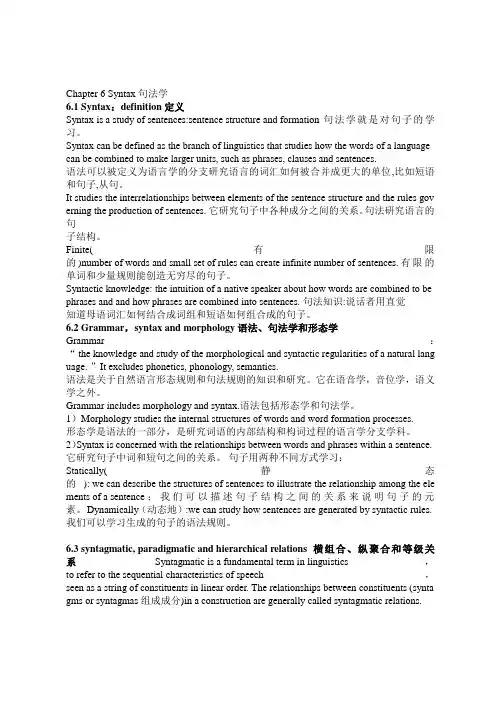
Chapter 6 Syntax 句法学6.1 Syntax:definition 定义Syntax is a study of sentences:sentence structure and formation 句法学就是对句子的学习。
Syntax can be defined as the branch of linguistics that studies how the words of a language can be combined to make larger units, such as phrases, clauses and sentences.语法可以被定义为语言学的分支研究语言的词汇如何被合并成更大的单位,比如短语和句子,从句。
It studies the interrelationships between elements of the sentence structure and the rules gov erning the production of sentences. 它研究句子中各种成分之间的关系。
句法研究语言的句子结构。
Finite(有限的)number of words and small set of rules can create infinite number of sentences.有限的单词和少量规则能创造无穷尽的句子。
Syntactic knowledge: the intuition of a native speaker about how words are combined to be phrases and and how phrases are combined into sentences. 句法知识:说话者用直觉知道母语词汇如何结合成词组和短语如何组合成的句子。
6.2 Grammar,syntax and morphology 语法、句法学和形态学Grammar :“the knowledge and study of the morphological and syntactic regularities of a natural lang uage. ”It excludes phonetics, phonology, semantics.语法是关于自然语言形态规则和句法规则的知识和研究。

语言学概论第6章重点Chapter 6 Syntax 句法学6.1 Syntax:definition 定义Syntax is a study of sentences:sentence structure and formation 句法学就是对句子的学习。
Syntax can be defined as the branch of linguistics that studies how the words of a language can be combined to make larger units, such as phrases, clauses and sentences.语法可以被定义为语言学的分支研究语言的词汇如何被合并成更大的单位,比如短语和句子,从句。
It studies the interrelationships between elements of the sentence structure and the rules gov erning the production of sentences. 它研究句子中各种成分之间的关系。
句法研究语言的句子结构。
Finite(有限的)number of words and small set of rules can create infinite number of sentences.有限的单词和少量规则能创造无穷尽的句子。
Syntactic knowledge: the intuition of a native speaker about how words are combined to be phrases and and how phrases are combined into sentences. 句法知识:说话者用直觉知道母语词汇如何结合成词组和短语如何组合成的句子。
6.2 Grammar,syntax and morphology 语法、句法学和形态学Grammar :“the knowledge and study of the morphological and syntactic regularities of a natural lang ua ge. ”It excludes phonetics, phonology, semantics.语法是关于自然语言形态规则和句法规则的知识和研究。

pederson et al. (1998) 语言类型学
《语言类型学》是中西书局出版的图书,作者刘丹青、曹瑞炯,本书共分为五讲,系统地梳理了语言类型学形成的历史、内涵、创立背景和逻辑过程等相关知识。
语言学的研究既要注意到同一语言在不同历史阶段的形态演变,也要注意到不同地域不同语言的结构与功能差异,以这种更广阔的研究视野为背景,强调跨语言验证的语言类型学得以逐步形成。
语言类型学是在跨语言考察基础上,总结人类语言的共性和类型差异,对于每一类进入语言库藏的范畴,类型学都可以在不同种类语言的对比中,研究这些范畴与其他类型特征可能存在的蕴含或和谐关系。
本书系统地梳理了语言类型学形成的历史和逻辑过程。
通过与形式学派、功能学派和认知学派的对比,介绍了语言类型学产生的现代语言学背景,说明了语言类型学派研究方法的基本特征;通过系统梳理早期类型派学者的研究课题,尤其是对Greenberg的经典类型学研究文献的精讲,阐释了语言类型学早期的主要思想和成果;通过对后续主要类型派学者研究课题的介绍以及他们之间承转关系的讲解,阐释了语言类型学逐步发展并成为独立学派的进程。
在共时维度,本书通过准确而具体地案例,把西方语言学家的类型学理论与不同语言实际结合分析,清晰地描述了语言类型学的核心课题和主要贡献。
阐释了语言类型学所涉及的语言现象的等级序列、语序模型及其原则、语序共性等问题,并系统介绍了语言库藏类型学的内涵、创立背景及主要课题。
在*后一部分,本书开创性地提出,建立语言类型学的分支
——库藏类型学。